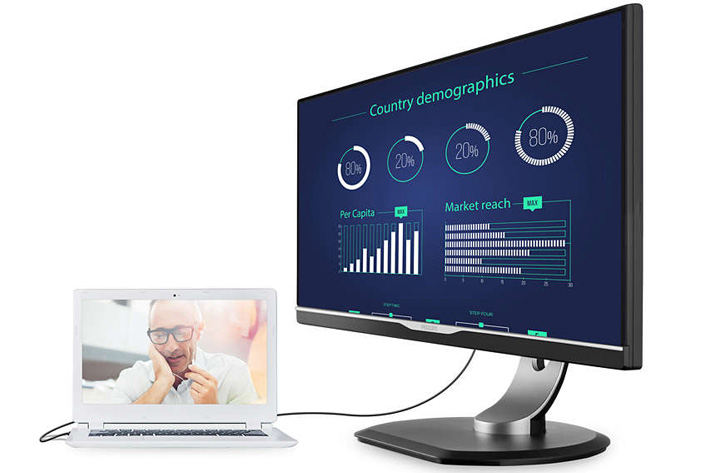
Scheduled for release this June, the 258B6QUEB QHD display is the first with USB Type C connectivity that MMD, the technology company and brand license partner for Philips Monitors, is bringing to market.
The USB Type C connector is, apparently, the solution to multiple connection problems we’ve had with different types of connections… and USBs. The USB Type C connector is not a new standard, but a solution for all the problems of having to pair different connectors. It will be compatible with previous connectors, through a physical adapter, while it offers a universal connector that not only doubles the capacity of USB 3.0 in terms of transfer, but also can share power… much more power.
What this means is that with one single cable users can do multiple things: transfer data securely at ultra-fast speeds, charge their devices, hook up their display to phones and notebooks, and connect to peripherals attached to their notebook. And the beauty of it is that the irritating problem of not getting your USB cable inserted the right way is gone with USB Type C: it works whichever way you connect it!
The connector itself is just a new connector that is considered to be a future-proof design, meaning it will be used, among other things, for the implementation of future USB technology. Right now it comes associated with USB 3.1, and that’s where it gets its speed from. USB 3.1, which was released in 2013, offers up to 10 Gbps.
The new Apple’s 12-inch MacBook is the first notebook with a USB Type C connector as its power port and to connect peripherals. Google’s Chromebook Pixel also has USB Type-C connectors, two of them, used to charge the computer, transfer data, charge other devices and, if you want, send out 4K video using an optional adapter.
Intel also joins in, with their Thunderbolt 3 connection using the USB Type-C design, a move that will help to make the “standard” stronger. And everything from smartphones to motherboards and hard drives will, in the near future, adopt the connector. The fact that it can share power in ways never experienced before may dictate new trends when it comes to using external hard drives. And more…
It is within this scenario that the new monitor from Philips arrives. The display supports transfer speeds of up to 10 Gbps (or 1,280 MB/s) with Gen-2 USB 3.1, and up to 5 Gbps with Gen-1 USB 3.0. USB 3.1 is 20 times as fast as USB 2.0: a 4K movie, for example, can be transferred in less than 60 seconds. The connector’s slim profile makes it suitable for both ultra-portable devices and standard notebooks. The video choices are also broad: as well as DisplayPort 1.2, HDMI, DVI and VGA are supported.
Commenting on the forthcoming release, Albert Ulfman, Product Manager Philips monitors Europe at MMD, says: “Efficient connectivity nowadays plays a vital role in keeping people productive. So we’re delighted to offer users this new 25-inch display with the latest and best USB connectivity on the market. USB-C even allows users to power and charge their notebooks from the monitor, eliminating the need for extra power cables. All the connections – power, video and data – go through one simple cable.”
The new connector is, according to Philips Monitors, just one of the reasons why the 25-inch QHD display is a great choice for professionals. Apart from its connectivity, it boasts many of the standout features that have earned Philips monitors their solid reputation in the market: the SmartErgoBase, for example, enables users to tilt, swivel and raise the display to precisely the position that works best – ideal for health and well-being at work. The base also hides the cables. The display’s ultra-narrow border creates a seamless look, maximizing the viewing area and creating less distraction for the eyes. The robust design, with 65% post-consumer recycled plastics, makes it a great choice for eco-friendly productivity.
The new Philips 258B6QUEB QHD (2560 x 1440 @ 60 Hz) display is available this June with a suggested price of £ 349 (+/- $500).
